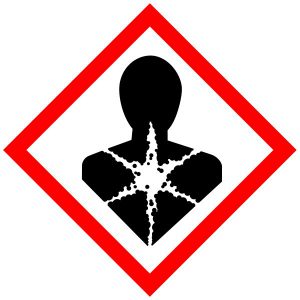
Hazard pictograms are a major component of the GHS (Globally Harmonized System for Hazard Classification and Labelling of Chemicals). The GHS includes two sets of pictograms: one set used for labelling containers and for workplace hazard warnings, and a second set used during the transport of dangerous goods (TDG).
The GHS pictogram is a graphical representation that includes a symbol along with other graphic elements such as a border, background pattern or color intended to convey specific information. The GHS pictograms are intended to replace older systems such as Canada’s WHMIS (Workplace Hazardous Materials Information System) and the European Union pictograms as defined in the Dangerous Substances Directive.
The following is a description of the GHS pictograms used during the Transport of Dangerous Goods (TDG).
Class 1: Explosives
1. Divisions 1.1, 1.2, 1.3:
a. Division 1.1: Substances and articles which have a mass explosion hazard
b. Division 1.2: Substances and articles which have a projection hazard but not a mass explosion hazard
c. Division 1.3: Substances and articles which have a fire hazard and, either a minor blast hazard (or both), but not a mass explosion hazard
2. Division 1.4: Substances and articles which are classified as explosives but which present no significant hazard
3. Division 1.5: Very insensitive substances which have a mass explosion hazard
4. Division 1.6: Extremely insensitive articles which do not have a mass explosion hazard
Class 2: Gases
1. Division 2.1
(Flammable gases)
Gases which at 20ºC and a standard pressure of 101.3 kPa:
-are ignitable when in a mixture of 13 percent or less by volume with air; or
-have a flammable range with air of at least 12 percentage points regardless of the lower flammable limit
2. Division 2.2
(Non-flammable non-toxic gases)
Gases which:
-are asphyxiant: gases which dilute or replace the oxygen normally in the atmosphere; OR
-are oxidizing: gases which may, generally by providing oxygen, cause or contribure to the combustion of other material more than air does; OR
-do not come under the other divisions
3. Division 2.3
(Toxic gases)
Gases which:
-are known to be so toxic or corrosive to humans as to pose a hazard to health; OR
-are presumed to be toxic or corrosive to humans because they have an LC50 to or less than 5000 ml/m3 (ppm)
Classes 3 and 4:
Flammable liquids and solids
1. Class 3
(Flammable liquids)
-Liquids which have a flash point of less than 60ºC and which are capable of sustaining combustion
2. Division 4.1
(Flammable solids, self-reactive substances and solid desensitized explosives)
-solids which, under conditions encountered in transport, are readily combustible or may cause or contribute to fire through friction
-self-reactive substances which are liable to undergo a strongly exothermic reaction
-solid desensitized explosives which may explode if not diluted sufficiently
3. Division 4.2
(Substances liable to spontaneous combustion)
-Substances which are liable to spontaneous heating under normal conditions encountered in transport, or to heating up in contact with air, and being then liable to catch fire
4. Division 4.3
(Substances which in contact with water emit flammable gases)
-Substances which, by interaction with water, are liable to become spontaneously flammable or to give off flammable gases in dangerous quantities
Other GHS Transport Classes
Division 5.1
(Oxidizing substances)
-Substances which, while in themselves not necessarily combustible, may (generally by yielding oxygen) cause, or contribute to, the combustion of other material
Division 5.2
(Organic peroxides)
-Organic substances which contain the bivalent -O-O- structure and may be considered derivatives of hydrogen peroxide, where one or both of the hydrogen atoms have been replaced by organic radicals Division 6.1
(Toxic substances)
-Substances with: an LD50 value is less than or equal to 300 mg/kg (oral), or less than or equal to 1000 mg/kg (dermal); or an LC50 value less than or equal to 4000 ml/m3 (inhalation of dusts or mists)
Class 8
(Corrosive substances)
-Substances which: cause full thickness destruction of intact skin tissue on exposure time of less than 4 hours; or exhibit a corrosion rate of more than 6.25 mm per year on either steel or aluminum surfaces at 55ºC
NOTE: There are several pictograms that have been included in the UN Model Regulations but have not been incorporated into the GHS because of the nature of the hazards. These pictograms are: Class 6.2 (infectious substances), Class 7 (radioactive material), and Class 9 (miscellaneous dangerous substances and articles).
NOTE: For a description of the GHS hazard pictograms used for labelling containers and for workplace hazard warnings, see the article “GHS Pictograms Part 1”.
Simply Safety! incident management software can help protect you and your company by allowing you to be proactive in reducing risk and associated costs and keeping an accurate due diligence trail. Simply Safety! software program replaces paper-based or spreadsheet tracking with a modern efficient way to manage critical compliance data.
Looking for a better way? Call 1 800 862-9939 today to book a 20 minute online web demo of Simply Safety! for your management team!
Visit the Simply Safety! products page.
